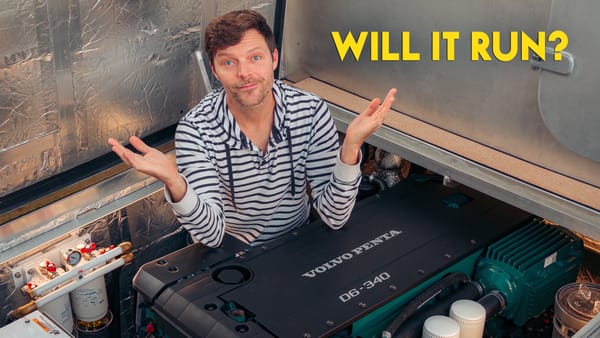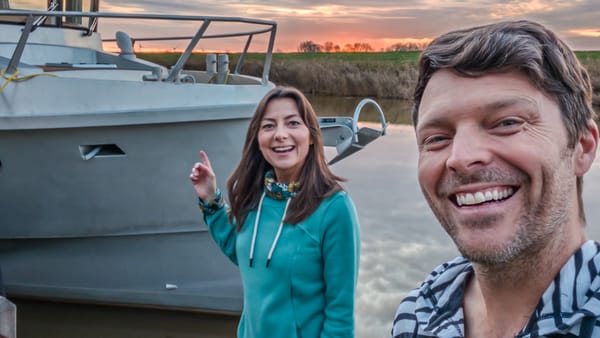Dinghy Swap – From Plush to Practical
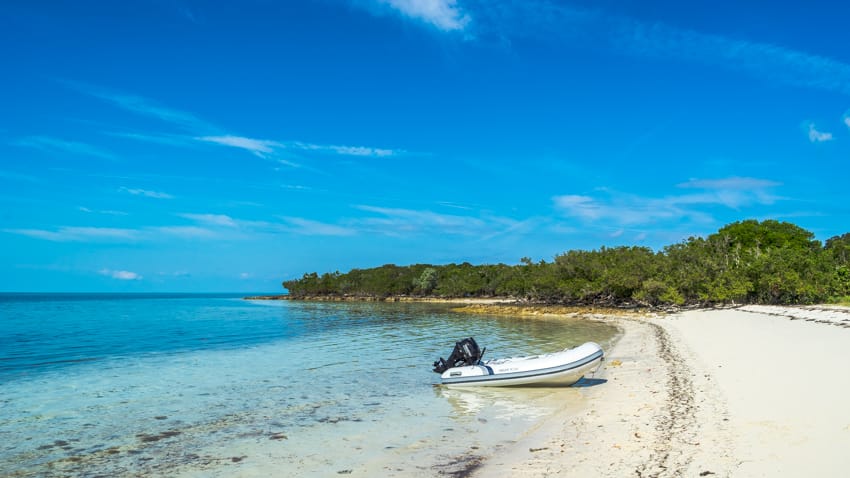
Coming from the world of RV travel we called our Smart car our Dinghy. From our experience, we put nearly as many miles on our Smart as we did on the motorhome. We pretty sure all the same rules will apply with our sailboat, so we’re not taking this dinghy swap decision lightly.
Since the first day we looked at our sailing catamaran we knew the center console dinghy would have to go. Mainly because of the weight. The heft was causing stress cracks on parts of the boat. For the past six months we’ve been researching, talking to fellow sailors and picking the brains of every cruiser we’ve shared a sundowner with. We’ve taken all the information, coupled it with our personal needs and now we’re swapping out our plush dinghy for something more practical.
Plush AB Dinghy
As we mentioned in the video, there is only one reason we ended up with this dinghy: The seller of our catamaran wouldn’t sell the boat if we didn’t buy the dinghy too. Don’t get me wrong, it is a great dinghy and a very comfortable means of getting around. I can see why the previous owner loved this dinghy. For a retiree cruising the Bahamas a few months of the year, it’s a super plush ride. If I were him, I would’ve gone for the same thing.
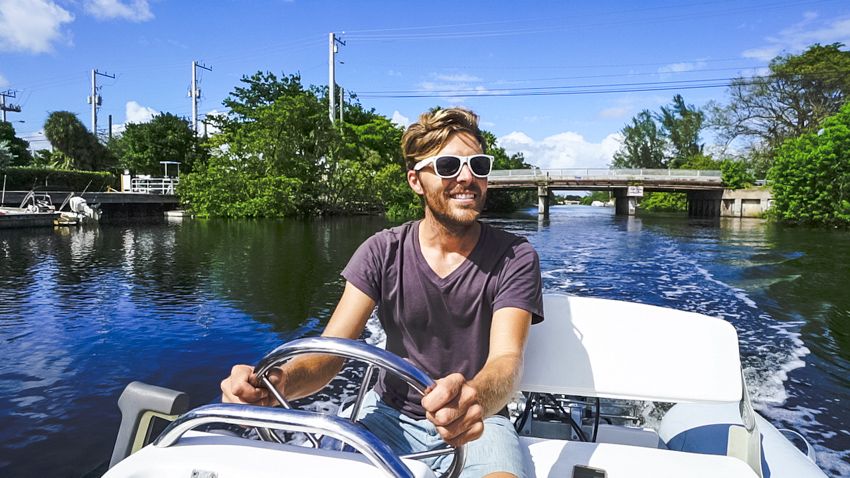
The biggest problem for us was the weight. It was far too heavy for our boat and we were advised by Kent (Just Catamarans) and Brian (our surveyor) to get a lighter dinghy. Aside from the weight, its flashy (hey look at me, follow me back to my yacht for expensive & fancy stuff!) and impractical for the type of cruising we plan on doing. The molded seats and center console take up a lot of room. We need space for dive gear, folding bikes, big provision runs and who knows what else. We need a dinghy that can take a beating on all the crazy adventures we have planned around the world, not a luxury cruiser.
The Specs: 2014 AB VSX: Fiberglass / Overall Length 10’6” / Overall Beam 5’ 7” / 4 Person Capacity / Weight 262lbs (no motor) / Honda 30HP Motor
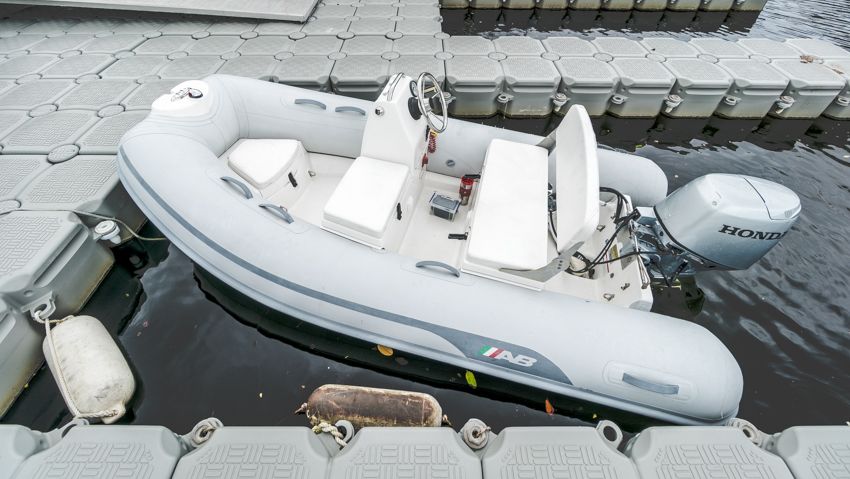
Practical New Dinghy
While doing my research, I did find there was a running theme: Your dinghy is your car. Get the biggest, deepest dinghy your sailboat will fit and the largest motor you can afford. I kept that in mind as we virtually shopped around for our perfect cruising dinghy.
For about 2 seconds I tried convincing Jason we should go with one of the unsinkable ridged boats like the Portland Pudgy. They are heavier and smaller but they can also be used as a self-rescue boat. I do still like the idea but it didn’t take long for Jason and Kent to double up on me with all the reasons why a rigid inflatable boat (RIB) was a smarter, more practical all around dinghy for our future about-the-world travels.
There were two big brands that stuck out as the best dinghy for sailing cruisers. AB and Highfield. Both have nice deep hulls, good space, and great reviews on ride and durability. We searched heavily for something used from either brand and found nada! I suppose that is a good sign. If you buy the right dinghy, you will use it and won’t need to sell it. So, a spankin’ new one is our only option.
The Highfield stood out with a few bells and whistles.
- Double deck hull (any water drains down to the lower hull to keep feet and belongings dry, helpful when provisioning).
- Seats have cushioned canvas covers with storage pockets, and they are fully removable to make way for gear.
- It’s not as common. Seems everyone around us has an AB and we like to be a little different when we can.
- It’s a tad cheaper and we’re all about saving a few bucks where we can.
The Specs: 2016 Highfield CL 310 BL: Aluminum / Overall Length 10’5” / Overall Beam 5’7” / 5 Person Capacity / Weight 110lbs (no motor) / Max load 1213lbs / Tohatsu 20HP Motor
Here’s the link to our dinghy – NauticalVentures.com/inventory-t/4793201 5% off if you use discount code: WYNNS
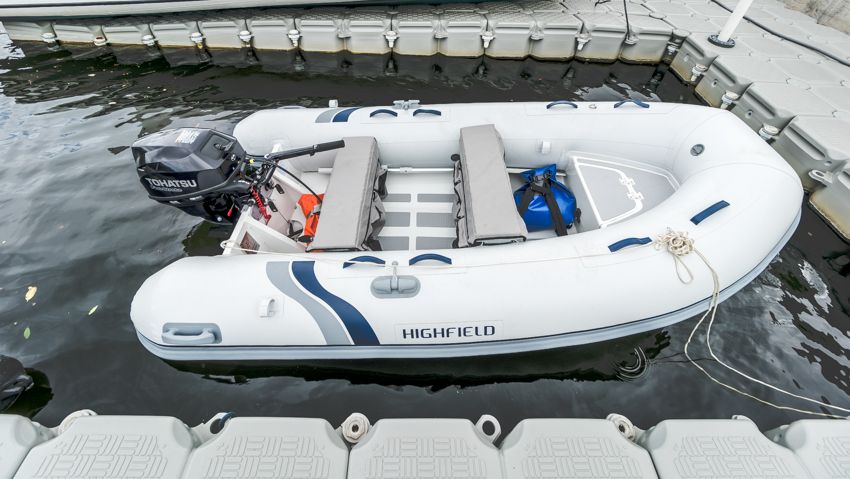
Dinghy Engine
Yamaha and Tohatsu seemed to be the two prominent brands among cruisers. Both were touted as easy to get parts from a worldwide dealer network (also because of popularity around the world), low maintenance needs and generally reliable. Through my conversations it seemed there were a few more Tohatsu fans we spoke to who had good customer service stories (customer service is critical because when you need it, it means something is wrong and you need help) and it was slightly cheaper than the Yamaha.
We went above the maximum 15HP recommendation and purchased the Tohatsu 20HP. Say what, above the recommended amount?! Basically, a 15hp is a de-powered 20hp, meaning you get all the size and weight with less horsepower! That just seemed silly, so we opted for the extra power.
Our outboard motor is a four-stroke. We seriously debated waiting till we arrived in the Bahamas to purchase a two-stroke engine because that seemed to be everyone’s advice.
- The benefits of a 2 stroke are (generally speaking): lighter weight, more powerful (i.e. faster to get to a plane), more compact size and easier to service.
- The downsides: Less eco-friendly, louder, smelly exhaust, omits more emissions into the atmosphere, required to add expensive oil separate from fuel and most importantly we weren’t sure of the dealer and warranty situation.
The environmental aspect of the downsides was a big one to us. Call us tree huggers if you want (I consider it a compliment) but our planet takes a beating and if there is an option with a lesser impact, we’ll take it.
It’ll be interesting to see what happens when our engine breaks down for the first time. Will we be able to service it ourselves or is it so complicated we have to bring it in? Let’s hope our mechanical skills have time to improve before that happens.
Dinghy Extras
We didn’t go crazy on extras and wanted to keep our dinghy simple, especially for now.
- Extra seat – It comes with one (canvas covers are included) but we knew we would want the extra seat for guests (we were thinking of you mom).
- Navigation light – very important for night time travel. This one is a bright LED that is suction cup or magnetic, so it sticks to the engine cover. Here’s the one we purchased, it’s expensive but it’s way better than the offerings we found from West Marine: http://amzn.to/2g3em3X
- Potential Future Project – I am considering making chaps as we hear it helps prolong the life of the dinghy. But honestly, we have tackled so many boat projects over the last six months…I had no desire to take on another multi day project yet.
Our dinghy did come with plenty of extras like a pump, patch kit, oars, dry bag, etc. so we’re set on all that for now.
Another thing that drew us to the Highfield brand is the “add a center console” option (it’s called FCT console). Pull up the rubber non-skid panels and a few threaded holes are revealed. It’s supposed to be a drop-in addition for many of their dinghy’s and it doesn’t monopolize as much space as a traditional fiberglass center console dinghy. Who doesn’t like flexibility!? If we decide someday we don’t like the throttle on a stick we currently have, we can always upgrade.
Sizing It Up
We are very happy cruisers with what we have. If we were to do it again, we would have gone with the same but most likely one size up. We were nervous about the next size up dinghy fitting between our sugar scoops. After spending some time with our 10’ dinghy, I think we could have made it work. The benefit of the 11 would have been:
- Second bow locker to keep our anchors and fuel tank separate
- Capacity of 6 people vs 5
- 20HP Engine is ok (we wouldn’t be above the recommended HP)
That’s about it. If we’ve left anything out that you are still pondering, leave us a note in the comment box below. If you have a different take on the best dinghy for a sailing cruiser, please share your thoughts. It’s always interesting to hear what works for others because this isn’t a one-size-fits-all kind of thing. We all do things a little differently and we learn from each other along the way.
Thanks for joining us!!!


